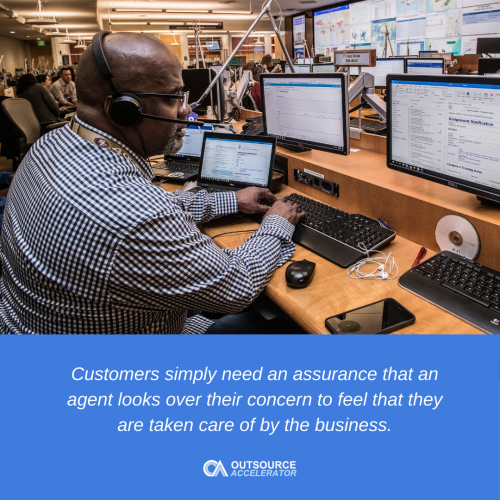Key performance indicators (KPIs) are important in measuring whether a business performs well in terms of different aspects such as finances, product quality, and marketing. Business process outsourcing companies also use these to measure how good their performance is in serving customers, especially in support services.
Call centers follow standard KPIs in measuring the quality of service they give for every call. However, businesses should also know and be aware of these for several reasons.
- Performance monitoring. One of the reasons for outsourcing customer service is to improve the support given to the customers. With this, businesses should keep track of their call center’s performance through these KPIs.
- Budget tracking. This is also important whether they hire their call centers on-demand or monthly. Measuring KPIs help them track the average call duration for each customer and the extra charges they concur if applicable.
- Process improvement. Tracking customer service KPIs help them improve the process of their support team. Streamlining calls, simplifying processes, and defining the product better helps their team solve customer issues in a shorter period.
Call centers use a lot of KPIs in different industries and conditions. With this, businesses should only lookout on what will apply to their operations. Below are some of the most important KPIs that businesses should measure.
Inbound KPIs
When a business wants to measure how their inbound customer and technical support perform, they use the following indicators to measure the duration and quality of their calls.

1. First response time
Quality customer service should be speedy. This is why call centers measure first response time to determine how quickly an agent responds to their first issue.
An issue does not require to be resolved right away to measure this. According to a study, customers prefer having their issues responded immediately even if it’s not resolved yet. Customers simply need assurance that an agent looks over their concerns to feel that they are taken care of by the business.
2. Average speed of answer
Calls are also measured depending on how quickly an agent picks up a call. The average speed of answer (ASA) determines the team’s efficiency, performance, and accessibility by answering the phone. However, this indicator can be difficult to interpret.
ASA is computed through the total waiting time over the total number of answered calls. Per industry standards, a team’s ASA should be 28 seconds. An agent should not be too quick or too slow to pick-up a call.
3. First call resolution
First call resolution determines how efficiently an agent has resolved an issue on a customer’s first call. This aims to avoid the customer from calling back, getting transferred often, or escalating the issue.
When a customer calls, they are reminded that their calls are recorded to ensure its quality. This indicator is measured through the percentage of customers resolving their issue when they first called over the total number of resolved issues in a period.
4. Average handling time
Average handling time (AHT) measures the average work to be done by the agent during and after a call. Depending on the team, a call may consist of answer speed, transfers, hold, and escalation, if necessary.
Unlike average call duration, AHT does not include ring time and queue since the latter only counts the entire transaction over the phone. However, factors such as abandoned call and wrap time affect its calculation.
5. Escalation rate
When an agent or a department cannot initially resolve a customer’s issue, chances are they get escalated to a more appropriate team that can help them with their concern. Escalation rate measures the number of calls escalated over the total number of calls in a period.
Escalation happens either because the agent does not have enough knowledge to resolve it or the customer asked for it to do so. Measuring this helps in lessening these incidents and provide a better service.
6. Inbound abandon rate
Abandon rate refers to calls abandoned by a customer before their transaction is initiated or finished. For inbound customer service, a customer may abandon a call before an agent picks up, while on hold, or in the middle of the transaction due to outside factors.
Waiting times largely affect a call. The longer time customers wait on the line, the less satisfaction a customer gets. This results in them dropping the call before or in the middle of the transaction.
7. Average call transfer rate
The Average call transfer rate, meanwhile, deals with the number of times an agent transfers a call to resolve an issue. In some cases, call transfers are acceptable especially if they serve as the virtual reception for the support team, such as in a telephone answering service.
Some calls, meanwhile, need the expertise of a different department to be resolved. For instance, invoice requests and inquiries should be handled by the accounting and finance team.
8. Customer satisfaction rate
Customer satisfaction rate (CSAT) is the most popular way to measure a team’s customer service. This indicates how satisfied a customer is with their service, if the agents approached them well, and if their issues are resolved at the end of their transaction.
Call centers use different ways to measure customer satisfaction. This includes giving scaled ratings and yes-or-no questionnaires after the call. Nowadays, a lot of them also ask for feedback on what they should improve on their service.
9. Net promoter score
The net promoter score (NPS) is usually tied to CSAT. This, meanwhile, measures how likely the customer will refer their assigned agent to other customers. NPS usually includes the attitude of the agent, their professionalism in handling a call, and their courtesy toward the customer.
An agent’s performance is scaled from 1 to 10, with each rating divided into three categories: promoters (9-10), passives (7-8), and detractors (0-6). Most companies include this to an employee’s file which counts toward their performance review.
10. SERVQUAL (Service + Quality)
A moniker of “service” and “quality,” SERVQUAL measures the overall quality that the team gave to their customers over their expectations. SERVQUAL is determined in five elements:
- Reliability. How consistent the team was in providing their promised service. This measures if they have met or exceeded their services given.
- Assurance. How they build trust and confidence in their customers through their team’s knowledge and responsiveness.
- Tangibles. The appearance and presentability of the company. For instance, its office, the employees, their equipment, etc.
- Empathy. The prioritized help of agents. This measures how they reach out to the individual needs of their customers.
- Responsiveness. How willing the team is to provide their customers’ needs and resolve their concerns.
Outbound KPIs
Usually, outbound KPIs are measured similarly to their inbound counterparts. Some of them are determined by unique factors required in reaching sales and lead generation quota. Here are the most important outbound KPIs to measure.

11. Customer retention rate
Attracting new customers costs more for the business than retaining them. With this, businesses should keep an eye on their existing customers and how much of them remain in the business over time.
Customer retention rate deals with the number of customers loyal to the company. This helps to strengthen the relationship between existing customers and the company. Do customers sign up for updates? Do they continuously subscribe to the services of the company? How many are satisfied with the products they get? These are a few of the qualities looked upon by this indicator.
12. Conversion rate
Conversion rate, meanwhile, determines the number of leads converted over the total number of leads generated in a single period. This indicator is important when they handle an outbound lead generation team.
This KPI follows the ‘sales funnel’ method. For instance, of their 1000 leads a month, 500 took interest in their services but only 250 signed up to the website and 100 closed a sales transaction. Converted into a percentage, they will then get the conversion rate of their team.
13. First call close
Like in first call resolution, the first call close (FCC) determines the number of sales transactions done in each customer’s first call. FCC applies to both new and existing customers contacted through lead generation.
Closing a sales transaction at first call may be difficult. However, each successful first call indicates the efficiency and good performance of an outbound team.
14. Calls per agent
Since most outbound teams have a specific quota to reach, each calls done by their agents is also measured. Calls per agent indicate the number of calls and engagements done by an agent. This also measures their efficiency whether they entertain or ignore customers or excuse themselves as away or idle.
15. Calls per account
Calls per account determine whether a lead should still stay in the company’s record or not. This counts the number of calls done to a single lead. The more times they abandon a call or reject a sales offer, the more likely they will be removed since they don’t show any interest in the company’s services.
16. Cost per call
A part of cost-benefit analyses, cost per call indicates the amount needed to operate the team over the total number of outbound calls. This determines the efficiency of the team and is used to control costs in running outbound call centers.
17. Outbound abandon rate
Abandonment rate for outbound, meanwhile, is determined by the customer picking up a lead call and whenever they dropped the transaction before a sales deal closes. This measures the customer’s interest in a service or product and their satisfaction in a transaction.
18. On-call rate
The on-call rate may be tied with calls per agent KPI since they both determine an agent’s average calls. This indicator, meanwhile, tells the average time an agent spends on calls over time spent between them. In-between call activities may include taking notes, processing transactions, and idle times.
Like calls per agent, the on-call rate determines the efficiency of an agent during call transactions, which may include hold time.
19. Call quality analysis
Call quality analysis works the same as inbound CSAT. Meanwhile, this determines the satisfaction of a customer during a call. Does an agent sound entertaining or intimidating? Do they provide accurate information? Are the deals convincing enough to attract a customer? These are some of its determiners.
Employee satisfaction
An agent’s performance usually reflects the level of care given by the management. The better they are taken care of, the better service they give to the customers. This is why measuring employee’s satisfaction through their engagement is important.

20. Employee engagement
Employees are considered as internal customers of the company. To provide a good service to their clients, they should also be taken care of by the business and their BPO company.
Employee engagement determines how the employee engages in a call or an internal operation. This covers whether they are satisfied with their line of work, with their salary, and with their work environment. In the end, a satisfied employee gives out their best effort to serve their clients.

No comments:
Post a Comment